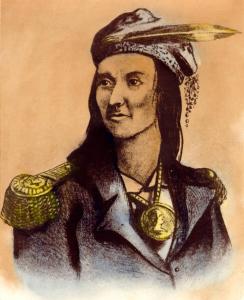American Indian Week


Did you know that this week, September 22 through 28, has been designated as American Indian Week in Ohio? This statewide event became official with the passage of HCR 26 by the 130th General Assembly. The resolution reads in part that “the members of the 130th General Assembly of the State of Ohio designate the fourth week of September as “American Indian Week,” in conjunction with “American Indian Day” on the fourth Saturday of September, to honor the significant influence that American Indians have had on Ohio and to encourage the teaching and sharing of their culture.” The contributions of this group to Ohio’s past, present and future are represented through exhibits at the Ohio History Center, through a number of our historic sites around the state, and through material available on Ohio Memory!
Ohio’s earliest inhabitants were here long before the arrival of Europeans and the settlement of the state and nation we know today. The state had a rich and thriving community of American Indians as far back as the prehistoric era, beginning with Paleoindian nomadic hunters who arrived in the area around 15,000 years ago at the end of the Ice Age. The first written accounts of Ohio’s American Indian communities come from French missionaries who entered the region in the late seventeenth and early eighteenth centuries. From these missionaries, historians know that six major groups settled in Ohio and its neighboring states: the Shawnee (in southern Ohio), Seneca-Cayuga (in central and northwest Ohio), Delaware (in eastern Ohio), Wyandotte (in northern Ohio), Ottawa (in northwest Ohio), and Miami (in western Ohio).

As time went on and one dominant cultural group gave way to another, American Indians played a pivotal role in shaping the history of both Ohio and the nation. Eventually, increasing tensions with European settlers in the Ohio Country flared into a series of conflicts known as the Ohio Indian Wars. Tecumseh, a Shawnee chief, is recognized as posing the most serious threat to white settlement of the Northwest Territory during the state of Ohio’s early years. He attempted to unite American Indian nations west of the Appalachian Mountains into a confederacy that could stand up against the United States military.
This effort was ultimately unsuccessful–the American Indians in the territory were outnumbered and didn’t have access to the firepower of the United States, and many were simply not willing to end their trade with U.S. settlers to take up arms against them. Tecumseh’s efforts to end white advancement into the native lands of the region’s tribes ended in 1813, with his death at the Battle of the Thames during the War of 1812. With Tecumseh’s death, large-scale American Indian resistance in Ohio came to an end. Tribes in the state agreed to abide by the terms of the Treaty of Greeneville, and over the coming years, various groups signed additional treaties relinquishing their remaining territory. By 1843, the last large group of American Indians in Ohio had been removed from their native lands.
Though the state’s tribes were largely removed by the mid-1800s, Ohio’s native inhabitants played a vital role in shaping the policy of the U.S. government toward the settlement of the lands west of the Allegheny Mountains and the treatment of indigenous peoples, and they left their mark in the place names, landscape, and culture of Ohio. We invite you to explore the stories told about Ohio’s American Indians on Ohio Memory as we recognize and celebrate the state’s pre-contact, historic and modern cultures!
Thanks to Lily Birkhimer, Digital Projects Coordinator at the Ohio History Connection, for this week’s post!



Leave a Reply
You must be logged in to post a comment.